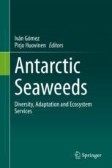Search
Search Results
-
Corallivory on small Porites colonies increases with coral colony size but is reduced by macroalgal associational refuge
Numerous tropical macroalgae provide associational refuge to other benthic organisms, presumably due to their physical structure and/or production of...

-
Olfactory misinformation provides refuge to palatable plants from mammalian browsing
Mammalian herbivores browse palatable plants of ecological and economical value. Undesirable neighbours can reduce browsing to these plants by...

-
Efficient application of a browsing repellent: Can associational effects within and between plants be exploited?
Browsing can reduce forest productivity, particularly when the apical shoots of trees are damaged. Repellents are used widely to reduce browsing, but...

-
Develo** best practices for the restoration of massive corals and the mitigation of predation impacts: influences of physical protection, colony size, and genotype on outplant mortality
Coral reefs have undergone drastic declines due to anthropogenic and natural disturbances. In response, restoration efforts were developed to recover...

-
Standing Litter Modifies Top-Down Effects of Large Herbivores on a Grassland Plant Community
Large herbivores can exert pronounced top-down effects on plant communities in grassland ecosystems. Previous studies highlighted the importance of...

-
Removal of invasive shrubs reduces rodent consumption of invasive non-native animals and native understory seeds
Plant invasions can generate indirect effects on native plants and animals by modifying the behavior and abundance of their consumers. Native...

-
Your enemy may be my friend: invasive legume attracts exotic herbivore in a tallgrass prairie
Effects of invasive exotic plants on plant communities are often profound, but interactions with higher trophic levels are less evident. Postulated...

-
A matter of proportion? Associational effects in larval anuran communities under fish predation
In Batesian mimicry, a species lacking defences against predators benefits from mimicking the aposematic signal of a defended species, while the...

-
Limited susceptibility of Lobophora to browsing fishes on inshore reefs of the Great Barrier Reef
Increases in the frequency, intensity and/or diversity of disturbances affecting coral reefs are leading to concerns; some reefs will be overgrown by...

-
Ecology and Evolution of Plant-Enemy Interactions during Early Colonization: Messages from a Land-Rising Archipelago
Plant-enemy interactions on islands are shaped by ecological and evolutionary processes during the history of the islands. It is, however, rare to be...
-
Host Plant Resistance to Insects in Vegetable Crops
Host plant resistance is an effective approach to manage insect pests in vegetable crops. This approach involves the use of plant traits that deter...
-
Ecosystem Services of Agroforestry: An Introduction
Ecosystem services (ES) are the benefits that people obtain from ecosystems. The term became popular in both scientific literature and common...
-
To change or not to change: drivers of defensive secondary metabolite distribution in the red macroalga Plocamium sp.
Understanding the spatial distribution of intraspecific variation, like defense phenotypes of sessile organisms, is important for identifying drivers...

-
Transgenic Plants and Its Role in Insect Control
The issue of food security has gained global significance in both political and social discourse due to a projected worldwide population increase by...
-
An invasive plant provides refuge to native plant species in an intensely grazed ecosystem
Invasion by exotic plant species and herbivory can individually alter native plant species diversity, but their interactive effects in structuring...

-
Insects of Reproductive Structures
The insects that feed on reproductive structures of forest trees are not only economically important, they are fascinating examples of the ability of...
-
Chemical Mediation of Antarctic Macroalga-Grazer Interactions
Macroalgal forests along the western Antarctic Peninsula (WAP) support dense assemblages of small macroalgal-associated invertebrates, particularly...
-
Risk of bird predation and defoliating insect abundance are greater in urban forest fragments than street trees
Predation by natural enemies is important for regulating herbivore abundance and herbivory. Theory predicts that complex habitats support more...

-
Do pioneer species enhance early performance of native species in subtropical shrublands? An examination involving six native species in South China
This paper examines the following questions: (1) Do early pioneer species have a greater impact on the survival and growth of different successional...
-
Landscape-Based Habitat Engineering for Sugarcane Ecosystem: A Green Technological Option for Pest Management
A conceptual model of habitat augmentation for subtropical sugarcane ecosystem has been established to enhance its self-regulatory capacity for pest...

